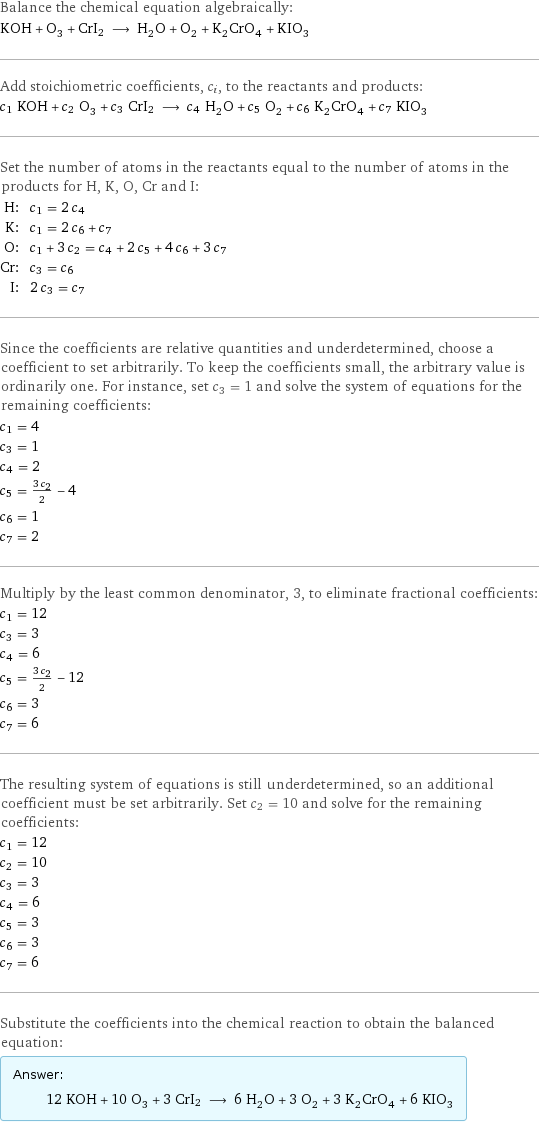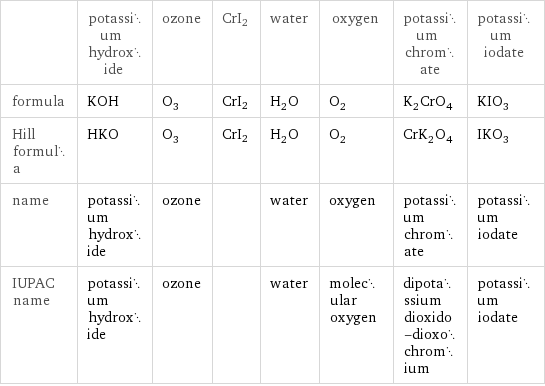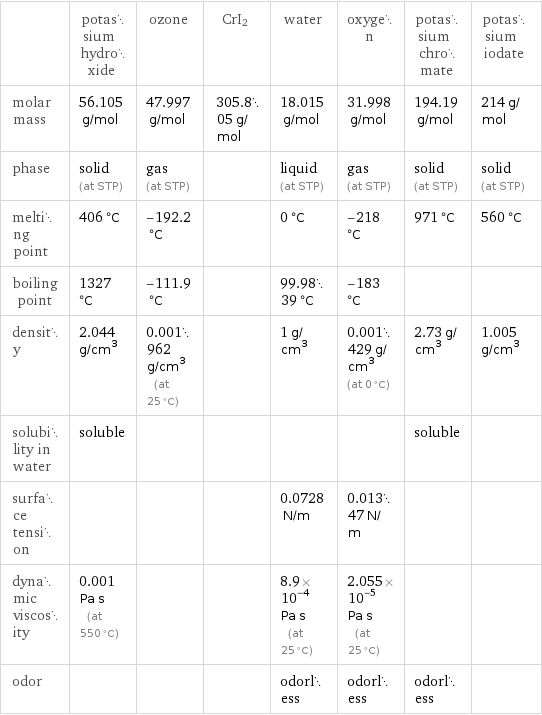Input interpretation

KOH potassium hydroxide + O_3 ozone + CrI2 ⟶ H_2O water + O_2 oxygen + K_2CrO_4 potassium chromate + KIO_3 potassium iodate
Balanced equation

Balance the chemical equation algebraically: KOH + O_3 + CrI2 ⟶ H_2O + O_2 + K_2CrO_4 + KIO_3 Add stoichiometric coefficients, c_i, to the reactants and products: c_1 KOH + c_2 O_3 + c_3 CrI2 ⟶ c_4 H_2O + c_5 O_2 + c_6 K_2CrO_4 + c_7 KIO_3 Set the number of atoms in the reactants equal to the number of atoms in the products for H, K, O, Cr and I: H: | c_1 = 2 c_4 K: | c_1 = 2 c_6 + c_7 O: | c_1 + 3 c_2 = c_4 + 2 c_5 + 4 c_6 + 3 c_7 Cr: | c_3 = c_6 I: | 2 c_3 = c_7 Since the coefficients are relative quantities and underdetermined, choose a coefficient to set arbitrarily. To keep the coefficients small, the arbitrary value is ordinarily one. For instance, set c_3 = 1 and solve the system of equations for the remaining coefficients: c_1 = 4 c_3 = 1 c_4 = 2 c_5 = (3 c_2)/2 - 4 c_6 = 1 c_7 = 2 Multiply by the least common denominator, 3, to eliminate fractional coefficients: c_1 = 12 c_3 = 3 c_4 = 6 c_5 = (3 c_2)/2 - 12 c_6 = 3 c_7 = 6 The resulting system of equations is still underdetermined, so an additional coefficient must be set arbitrarily. Set c_2 = 10 and solve for the remaining coefficients: c_1 = 12 c_2 = 10 c_3 = 3 c_4 = 6 c_5 = 3 c_6 = 3 c_7 = 6 Substitute the coefficients into the chemical reaction to obtain the balanced equation: Answer: | | 12 KOH + 10 O_3 + 3 CrI2 ⟶ 6 H_2O + 3 O_2 + 3 K_2CrO_4 + 6 KIO_3
Structures

+ + CrI2 ⟶ + + +
Names

potassium hydroxide + ozone + CrI2 ⟶ water + oxygen + potassium chromate + potassium iodate
Equilibrium constant
![Construct the equilibrium constant, K, expression for: KOH + O_3 + CrI2 ⟶ H_2O + O_2 + K_2CrO_4 + KIO_3 Plan: • Balance the chemical equation. • Determine the stoichiometric numbers. • Assemble the activity expression for each chemical species. • Use the activity expressions to build the equilibrium constant expression. Write the balanced chemical equation: 12 KOH + 10 O_3 + 3 CrI2 ⟶ 6 H_2O + 3 O_2 + 3 K_2CrO_4 + 6 KIO_3 Assign stoichiometric numbers, ν_i, using the stoichiometric coefficients, c_i, from the balanced chemical equation in the following manner: ν_i = -c_i for reactants and ν_i = c_i for products: chemical species | c_i | ν_i KOH | 12 | -12 O_3 | 10 | -10 CrI2 | 3 | -3 H_2O | 6 | 6 O_2 | 3 | 3 K_2CrO_4 | 3 | 3 KIO_3 | 6 | 6 Assemble the activity expressions accounting for the state of matter and ν_i: chemical species | c_i | ν_i | activity expression KOH | 12 | -12 | ([KOH])^(-12) O_3 | 10 | -10 | ([O3])^(-10) CrI2 | 3 | -3 | ([CrI2])^(-3) H_2O | 6 | 6 | ([H2O])^6 O_2 | 3 | 3 | ([O2])^3 K_2CrO_4 | 3 | 3 | ([K2CrO4])^3 KIO_3 | 6 | 6 | ([KIO3])^6 The equilibrium constant symbol in the concentration basis is: K_c Mulitply the activity expressions to arrive at the K_c expression: Answer: | | K_c = ([KOH])^(-12) ([O3])^(-10) ([CrI2])^(-3) ([H2O])^6 ([O2])^3 ([K2CrO4])^3 ([KIO3])^6 = (([H2O])^6 ([O2])^3 ([K2CrO4])^3 ([KIO3])^6)/(([KOH])^12 ([O3])^10 ([CrI2])^3)](../image_source/18ba9211b2e084280cc831d0c517caa7.png)
Construct the equilibrium constant, K, expression for: KOH + O_3 + CrI2 ⟶ H_2O + O_2 + K_2CrO_4 + KIO_3 Plan: • Balance the chemical equation. • Determine the stoichiometric numbers. • Assemble the activity expression for each chemical species. • Use the activity expressions to build the equilibrium constant expression. Write the balanced chemical equation: 12 KOH + 10 O_3 + 3 CrI2 ⟶ 6 H_2O + 3 O_2 + 3 K_2CrO_4 + 6 KIO_3 Assign stoichiometric numbers, ν_i, using the stoichiometric coefficients, c_i, from the balanced chemical equation in the following manner: ν_i = -c_i for reactants and ν_i = c_i for products: chemical species | c_i | ν_i KOH | 12 | -12 O_3 | 10 | -10 CrI2 | 3 | -3 H_2O | 6 | 6 O_2 | 3 | 3 K_2CrO_4 | 3 | 3 KIO_3 | 6 | 6 Assemble the activity expressions accounting for the state of matter and ν_i: chemical species | c_i | ν_i | activity expression KOH | 12 | -12 | ([KOH])^(-12) O_3 | 10 | -10 | ([O3])^(-10) CrI2 | 3 | -3 | ([CrI2])^(-3) H_2O | 6 | 6 | ([H2O])^6 O_2 | 3 | 3 | ([O2])^3 K_2CrO_4 | 3 | 3 | ([K2CrO4])^3 KIO_3 | 6 | 6 | ([KIO3])^6 The equilibrium constant symbol in the concentration basis is: K_c Mulitply the activity expressions to arrive at the K_c expression: Answer: | | K_c = ([KOH])^(-12) ([O3])^(-10) ([CrI2])^(-3) ([H2O])^6 ([O2])^3 ([K2CrO4])^3 ([KIO3])^6 = (([H2O])^6 ([O2])^3 ([K2CrO4])^3 ([KIO3])^6)/(([KOH])^12 ([O3])^10 ([CrI2])^3)
Rate of reaction
![Construct the rate of reaction expression for: KOH + O_3 + CrI2 ⟶ H_2O + O_2 + K_2CrO_4 + KIO_3 Plan: • Balance the chemical equation. • Determine the stoichiometric numbers. • Assemble the rate term for each chemical species. • Write the rate of reaction expression. Write the balanced chemical equation: 12 KOH + 10 O_3 + 3 CrI2 ⟶ 6 H_2O + 3 O_2 + 3 K_2CrO_4 + 6 KIO_3 Assign stoichiometric numbers, ν_i, using the stoichiometric coefficients, c_i, from the balanced chemical equation in the following manner: ν_i = -c_i for reactants and ν_i = c_i for products: chemical species | c_i | ν_i KOH | 12 | -12 O_3 | 10 | -10 CrI2 | 3 | -3 H_2O | 6 | 6 O_2 | 3 | 3 K_2CrO_4 | 3 | 3 KIO_3 | 6 | 6 The rate term for each chemical species, B_i, is 1/ν_i(Δ[B_i])/(Δt) where [B_i] is the amount concentration and t is time: chemical species | c_i | ν_i | rate term KOH | 12 | -12 | -1/12 (Δ[KOH])/(Δt) O_3 | 10 | -10 | -1/10 (Δ[O3])/(Δt) CrI2 | 3 | -3 | -1/3 (Δ[CrI2])/(Δt) H_2O | 6 | 6 | 1/6 (Δ[H2O])/(Δt) O_2 | 3 | 3 | 1/3 (Δ[O2])/(Δt) K_2CrO_4 | 3 | 3 | 1/3 (Δ[K2CrO4])/(Δt) KIO_3 | 6 | 6 | 1/6 (Δ[KIO3])/(Δt) (for infinitesimal rate of change, replace Δ with d) Set the rate terms equal to each other to arrive at the rate expression: Answer: | | rate = -1/12 (Δ[KOH])/(Δt) = -1/10 (Δ[O3])/(Δt) = -1/3 (Δ[CrI2])/(Δt) = 1/6 (Δ[H2O])/(Δt) = 1/3 (Δ[O2])/(Δt) = 1/3 (Δ[K2CrO4])/(Δt) = 1/6 (Δ[KIO3])/(Δt) (assuming constant volume and no accumulation of intermediates or side products)](../image_source/f605e3ce96438ee11790e9f858bdd8d4.png)
Construct the rate of reaction expression for: KOH + O_3 + CrI2 ⟶ H_2O + O_2 + K_2CrO_4 + KIO_3 Plan: • Balance the chemical equation. • Determine the stoichiometric numbers. • Assemble the rate term for each chemical species. • Write the rate of reaction expression. Write the balanced chemical equation: 12 KOH + 10 O_3 + 3 CrI2 ⟶ 6 H_2O + 3 O_2 + 3 K_2CrO_4 + 6 KIO_3 Assign stoichiometric numbers, ν_i, using the stoichiometric coefficients, c_i, from the balanced chemical equation in the following manner: ν_i = -c_i for reactants and ν_i = c_i for products: chemical species | c_i | ν_i KOH | 12 | -12 O_3 | 10 | -10 CrI2 | 3 | -3 H_2O | 6 | 6 O_2 | 3 | 3 K_2CrO_4 | 3 | 3 KIO_3 | 6 | 6 The rate term for each chemical species, B_i, is 1/ν_i(Δ[B_i])/(Δt) where [B_i] is the amount concentration and t is time: chemical species | c_i | ν_i | rate term KOH | 12 | -12 | -1/12 (Δ[KOH])/(Δt) O_3 | 10 | -10 | -1/10 (Δ[O3])/(Δt) CrI2 | 3 | -3 | -1/3 (Δ[CrI2])/(Δt) H_2O | 6 | 6 | 1/6 (Δ[H2O])/(Δt) O_2 | 3 | 3 | 1/3 (Δ[O2])/(Δt) K_2CrO_4 | 3 | 3 | 1/3 (Δ[K2CrO4])/(Δt) KIO_3 | 6 | 6 | 1/6 (Δ[KIO3])/(Δt) (for infinitesimal rate of change, replace Δ with d) Set the rate terms equal to each other to arrive at the rate expression: Answer: | | rate = -1/12 (Δ[KOH])/(Δt) = -1/10 (Δ[O3])/(Δt) = -1/3 (Δ[CrI2])/(Δt) = 1/6 (Δ[H2O])/(Δt) = 1/3 (Δ[O2])/(Δt) = 1/3 (Δ[K2CrO4])/(Δt) = 1/6 (Δ[KIO3])/(Δt) (assuming constant volume and no accumulation of intermediates or side products)
Chemical names and formulas

| potassium hydroxide | ozone | CrI2 | water | oxygen | potassium chromate | potassium iodate formula | KOH | O_3 | CrI2 | H_2O | O_2 | K_2CrO_4 | KIO_3 Hill formula | HKO | O_3 | CrI2 | H_2O | O_2 | CrK_2O_4 | IKO_3 name | potassium hydroxide | ozone | | water | oxygen | potassium chromate | potassium iodate IUPAC name | potassium hydroxide | ozone | | water | molecular oxygen | dipotassium dioxido-dioxochromium | potassium iodate
Substance properties

| potassium hydroxide | ozone | CrI2 | water | oxygen | potassium chromate | potassium iodate molar mass | 56.105 g/mol | 47.997 g/mol | 305.805 g/mol | 18.015 g/mol | 31.998 g/mol | 194.19 g/mol | 214 g/mol phase | solid (at STP) | gas (at STP) | | liquid (at STP) | gas (at STP) | solid (at STP) | solid (at STP) melting point | 406 °C | -192.2 °C | | 0 °C | -218 °C | 971 °C | 560 °C boiling point | 1327 °C | -111.9 °C | | 99.9839 °C | -183 °C | | density | 2.044 g/cm^3 | 0.001962 g/cm^3 (at 25 °C) | | 1 g/cm^3 | 0.001429 g/cm^3 (at 0 °C) | 2.73 g/cm^3 | 1.005 g/cm^3 solubility in water | soluble | | | | | soluble | surface tension | | | | 0.0728 N/m | 0.01347 N/m | | dynamic viscosity | 0.001 Pa s (at 550 °C) | | | 8.9×10^-4 Pa s (at 25 °C) | 2.055×10^-5 Pa s (at 25 °C) | | odor | | | | odorless | odorless | odorless |
Units
